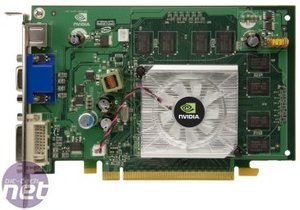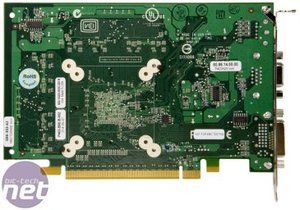GeForce 8500 GT
GeForce 8500 GT fills the gap between $89 and $129 USD – these are pretty heavy-volume price points, so it’s important for the balance between price and performance to be right. We’ve already covered the fact that GeForce 8500 GT is based on G86, which is a cut-down version of the G84 core.It comes with a full complement of G86 features, meaning that there are 16 stream processors, eight texture address units, eight texture filtering units, eight raster operators and a 128-bit memory bus width.
The reference clock for the core is set to 450MHz, while the shader and memory clocks are set to 900MHz and 800MHz (effective data rate) respectively. GeForce 8500 GT cards will be specified with 256MB of DDR2 memory, but I think it’s quite possible that we’ll see a 512MB version from someone (not that the card is going to need 512MB of local memory).
Despite the port configuration on Nvidia’s reference photography, GeForce 8500 GT has support for two dual-link DVI connectors, but it’s up to the board partners to include both of them. The card also has optional support for an HDMI port and HDCP and, again, it’s up to board partners to implement these features into their cards. We’re guessing that this, as well as the potential for a 512MB version, is where the upper end of Nvidia’s suggested pricing structure for GeForce 8500 GT comes into play.
Finally, you’ll get support for Nvidia’s second generation Video Processor and all of the PureVideo HD features, meaning that this card is suitable for using in a home theatre PC.
GeForce 8400 GS & GeForce 8300 GS:
In addition to the GeForce 8500 GT, there are two more products – namely GeForce 8400 GS and GeForce 8300 GS – based on G86 that will be available to OEMs only towards the end of the month. Nvidia tells us that it currently has no plans to sell these as retail parts, and that they were merely manufactured to satisfy orders from a number of OEM customers. Despite being based on the same GPU as GeForce 8500 GT, they use slightly different GPU configurations, which we’ll briefly discuss here.For starters, Nvidia has cut down the number of ROPs to four (or one ROP partition), meaning that there is only a 64-bit memory bus width available on both of these parts. As we have mentioned already, this is due to the nature of the way that Nvidia’s GeForce 8-series memory controller works – each 64-bit memory ‘channel’ is allocated to one raster operator partition, which contains four individual raster operators.
GeForce 8400 GS still features 16 stream processors and also sports the same texturing capabilities as GeForce 8500 GT too. With GeForce 8300 GS, Nvidia reduced the number of stream processors to eight, but the texturing capabilities remain unchanged and it’s still capable of eight texture address and eight bilinear texture filtering operations per clock cycle.
The clock speeds on both GeForce 8400 GS and GeForce 8300 GS remain the same as the GeForce 8500 GT at 450MHz core, 900MHz shader and 800MHz (effective) on the memory, but obviously the performance is going to be slightly lower for one or more of the reasons we’ve highlighted here. Finally, we don't have details of power consumption on GeForce 8400 GS and 8300 GS, but we expect them to consume between 35W to 40W.

MSI MPG Velox 100R Chassis Review
October 14 2021 | 15:04











Want to comment? Please log in.